by Carrie Stevenson | Jun 2, 2015
Hurricane Season began June 1. While storm experts are predicting a slower year due to El Nino conditions, it only takes a single storm landing nearby to cause millions in damage, uprooting trees and lives.
Tree damage to homes and property can be devastating, and one of the first instincts of many homeowners when they see a big storm in the Gulf is to start trimming limbs and removing trees. However, it is wise to fully evaluate one’s landscape before making an irreversible decision. Trees are crucial for providing shade (i.e. energy savings), wildlife habitat, stormwater management, and maintaining property values.
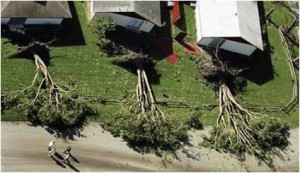
Downed trees in a row along a hurricane-devastated street. Photo Credit: Mary Duryea, University of Florida
University of Florida researchers Mary Duryea and Eliana Kampf have done extensive studies on the effects of wind on trees and landscapes, and several important lessons stand out. Keep in mind that reducing storm damage often starts at the landscape design/planning stage!
- Select the right plant for the right place.
- Post-hurricane studies in north Florida show that live oak, southern magnolia, sabal palms, and bald cypress stand up well compared to other trees during hurricanes. Pecan, water and laurel oaks, Carolina cherry laurel and sand pine were among the least wind resistant.
- Plant high-quality trees with strong central trunks and balanced branch structure.
- Longleaf pine often survived storms in our area better than other pine species, but monitor pines carefully. Sometimes there is hidden damage and the tree declines over time. Look for signs of stress or poor health, and check closely for insects. Weakened pines may be more susceptible to beetles and diseases.
- Remove hazard trees before the wind does. Have a certified arborist inspect your trees for signs of disease and decay. They are trained to advise you on tree health.
- Trees in a group (at least five) blow down less frequently than single trees.
- Trees should always be given ample room for roots to grow. Roots absorb nutrients, but they are also the anchors for the tree. If large trees are planted where there is limited or restricted area for roots to grow out in all directions, there is a likelihood that the tree may fall during high winds.
- Construction activities within about 20 feet from the trunk of existing trees can cause the tree to blow over more than a decade later.
- Plant a variety of species, ages and layers of trees and shrubs to maintain diversity in your community
- When a tree fails, plant a new one in its place.
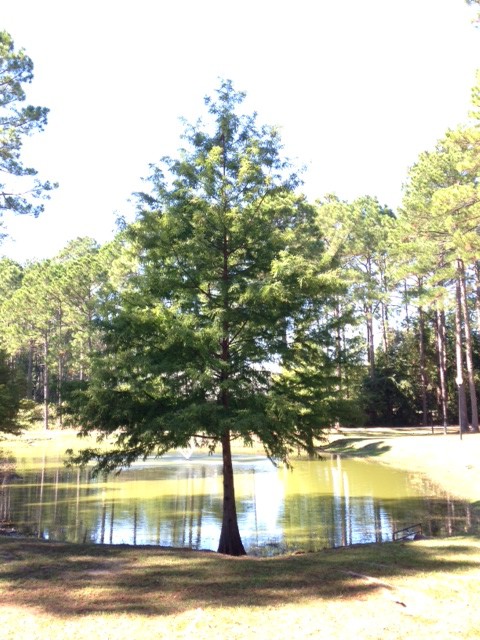
by Julie McConnell | Jun 2, 2015
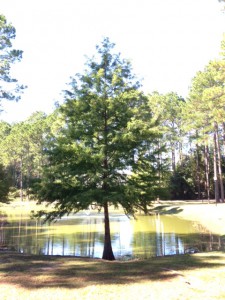
Bald cypress growing at the edge of a pond. Photo: Julie McConnell, UF/IFAS
Considering planting a tree in your landscape, but not sure what will do well?
Baldcypress, Taxodium distichum, is one tree you should consider for your Florida landscape. This deciduous conifer is native to North America and is suited to a wide variety of situations, even difficult ones!
Baldcypress is found naturally along stream banks and in swampy areas, but also performs well in dry situations once established. Not many trees can tolerate standing water or flooding situations, but baldcypress is well adapted to these tough spots. In areas that flood or remain wet the tree will form “knees” that project out of the ground and add a beautiful feature – just don’t plan to mow in areas where these develop. Not restricted to wet areas, baldcypress also performs well as a street tree or in limited root zone situations such as parking lot islands.
This tough tree has a soft, delicate leaf texture and interesting globular cones that start out green then turn brown as they mature. The foliage is light green through the spring and summer then turns a coppery gold before the needles fall in the winter. The trunk has a reddish color that is also attractive and will grow branches low to the ground, but can easily be maintained with a clear trunk in a street tree form.
Baldcypress will grow in full sun to part shade and is adapted to all soil types except highly alkaline (over 7.5 pH). Sand, loam, clay, or muck can all sustain this native tree. Few pests bother baldcypress, but it can be affected by bagworms and mites. Mature size can be in excess of 100 feet, but trees typically grow 60-80 feet tall in Florida.
For more information:
Taxodium distichum: Baldcypress
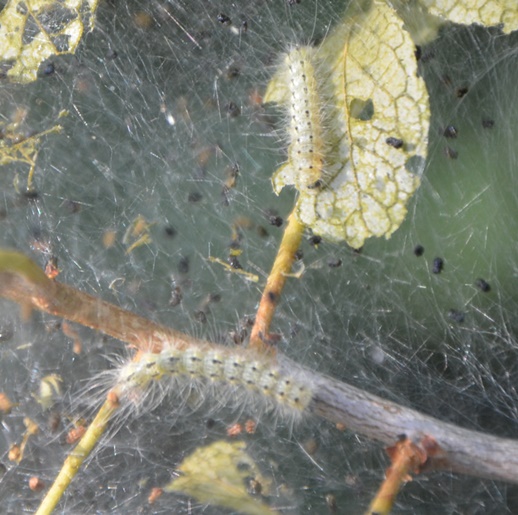
by Les Harrison | May 19, 2015
Uninvited guests can sometimes be fun and entertaining, bringing spontaneity to an otherwise predictable schedule. Sometimes the surprise guest is just an unpleasant distraction with no redeeming virtues.
The unanticipated knock on the door can bring both scenarios to mind. Almost everyone has an enjoyable cousin who regales listeners with amusing tales, and picks up the check for dinner.
Likewise, there are those potential callers with parasitic qualities, the appetite of a market hog, and initiative of a sloth. The Eastern Tent Caterpillar is one such visitor in north Florida.
These native caterpillars build large, thick nests on the branch forks and crotches of many kinds of trees, seeming to always choose the prized specimens highly valued by the homeowner. The silky tent shaped nests are easy to see and identity in host trees.
The caterpillars emerging in the spring of 2015 were laid in the spring of 2014. The adult moth lays her eggs in a single batch in May to July in the panhandle. There are 200 to 300 eggs laid in the group.
The mass of eggs are shiny, reddish-brown and look like dried foam. They are ordinarily about six inches back from the tip of a thin twig in host tree.
In approximately three weeks the eggs contain fully formed caterpillars, but the small caterpillars remain in the eggs until the following spring.
In late-February to mid-March they chew their way through their egg shells ready to eat their host tree that is entering the spring budding period with plentiful tender vegetation.
The voracious larvae immediately infest and, if in sufficient numbers, defoliate plum, cherry and many others. Normally the trees recover after a few weeks, but weakened or diseased trees may die.
When not eating, the newly hatched caterpillars construct their silk tent. The caterpillars use a pheromone trail to guild them back home when foraging is done.
A social insect, the eastern tent caterpillars congregate at their specific tent during the night and in rainy weather, expanding it to accommodate their growing size. These caterpillars do not feed within their nests.
The caterpillars disperse to colonize new areas when maturity is reached. They construct cocoons in protected places once they have sufficiently scattered.
Birds are not attracted to these hairy caterpillars. If they have a heavy concentration of black cherry leaves in their diet, the caterpillars will have a bitter acrid taste.
Parasitic wasps and weather are the two most common causes of caterpillar death. These caterpillars are especially susceptible to cold weather once they have emerged from their eggs.
About two weeks later, an adult moth emerges to begin the process again. Mating and egg laying commonly occur within 24 hours of the moths emerging from their cocoons
These brown moths are nocturnal and are seen flying only at night. They are an inch to two inches wingtip to wingtip at maturity and easy to overlook.

Tent Caterpillars are quick to hatch and eat their way through home landscapes.
Unfortunately, once they arrive for a visit they always overstay their welcome.
Contact your local UF/IFAS County Extension Office to learn more about Eastern Tent Caterpillars in north Florida.
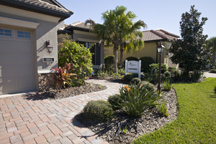
by Roy Carter | Apr 27, 2015

UF/IFAS Photo: Tyler Jones.
Most people know that an attractive landscape adds to the value of a home. For most of us, the landscape also represents a hefty investment of money, time and work so it’s important to know enough about landscape design to do the job right.
An important step in developing an attractive landscape is spacing plant materials correctly. Plants should be placed in the landscape in relation to each other, and with some understanding of their ultimate height, spread, and growth rate. However, the endless variety of plant sizes and shapes can easily complicate this matter for the home gardener.
How the plant is used in the landscape will determine its shape to a large extent. For example, if a plant is part of a hedge row, it should be placed close to the other plants so that in a few years, all of them grow together. If you want to retain the individual shape of each plant space the plants further apart.
Spacing trees correctly is very important as trees are the largest and most permanent of all landscape materials. Here are a few examples of some ways to use trees effectively around the home:
- Pine trees look very good as a tall background screen in the landscape. To have the trees work as a screen, plant them eight to twelve feet apart measuring from the center of one tree to the center of the next.
- Mass planting of dogwood, redbud and crape myrtle make brilliant assets to your landscape. If these trees are spaced about 12 to 15 feet apart, the top foliage should meet in a few years. When these trees are in bloom, the mass plantings will enhance their show of flowers.
- An oak tree planted on the west side of your lot will provide shade for your home, the tree should be planted about thirty feet from side of the house, to prevent tree limbs from eventually crowding the house.
As you can see, it’s important to learn as much as possible about trees you select for your landscape. In spite of the few examples given you, there is no single standard recommendation on spacing trees in the home landscape. This is because most of the popular landscape trees can range from 10 to 100 feet in height, and vary as much in spread. Specialists recommend that the minimum spacing for landscape trees should be one half of the spread of the tree’s mature canopy from other trees, from walls and other existing structures. But even this minimum spacing may vary among different varieties of the same species. For specific spacing requirements for the tree you are interested in check with your local County Extension Office.
by Julie McConnell | Apr 13, 2015
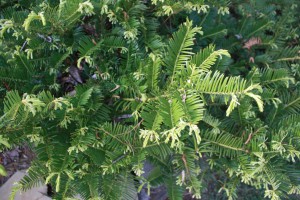
New foliage of Japanese Plum Yew Photo credit: Julie McConnell, UF/IFAS
Trying to grow turfgrass in shaded areas is a losing battle but that doesn’t mean you have to settle for mulch in those dark areas of the landscape. There are many plants that will tolerate shady conditions found under the canopy of large trees, and some offer year round interest!
One of the most important aspects of site assessment is sun exposure. Plants need light, but do not all need the same amount or intensity.
If plants requiring full sun are planted in the shade, they tend to get leggy and do not flower well. Although they may live, they will not perform at their peak.
Shade loving plants grown in the sun may be stunted, show leaf scorch, and will struggle. Most shade plants can tolerate some filtered light or morning sun, but need to be protected from direct mid-day to afternoon sun.
So, what evergreen plants can add some color and texture to your shaded spots?
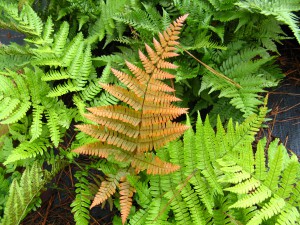
Golden tones of new foliage is what gives Autumn Fern its common name. Photo credit: Julie McConnell, UF/IFAS
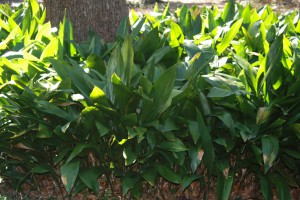
Cast Iron Plants under a live oak tree. Photo credit: Julie McConnell, UF/IFAS
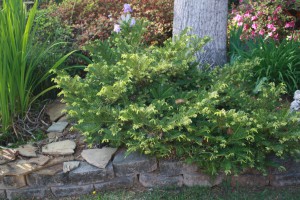
Japanese Plum Yew. Photo credit: Julie McConnell, UF/IFAS
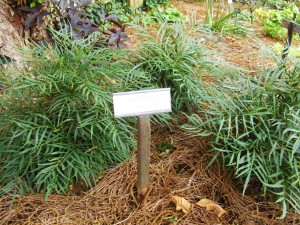
Soft Caress Mahonia. Photo Credit: Julie McConnell, UF/IFAS
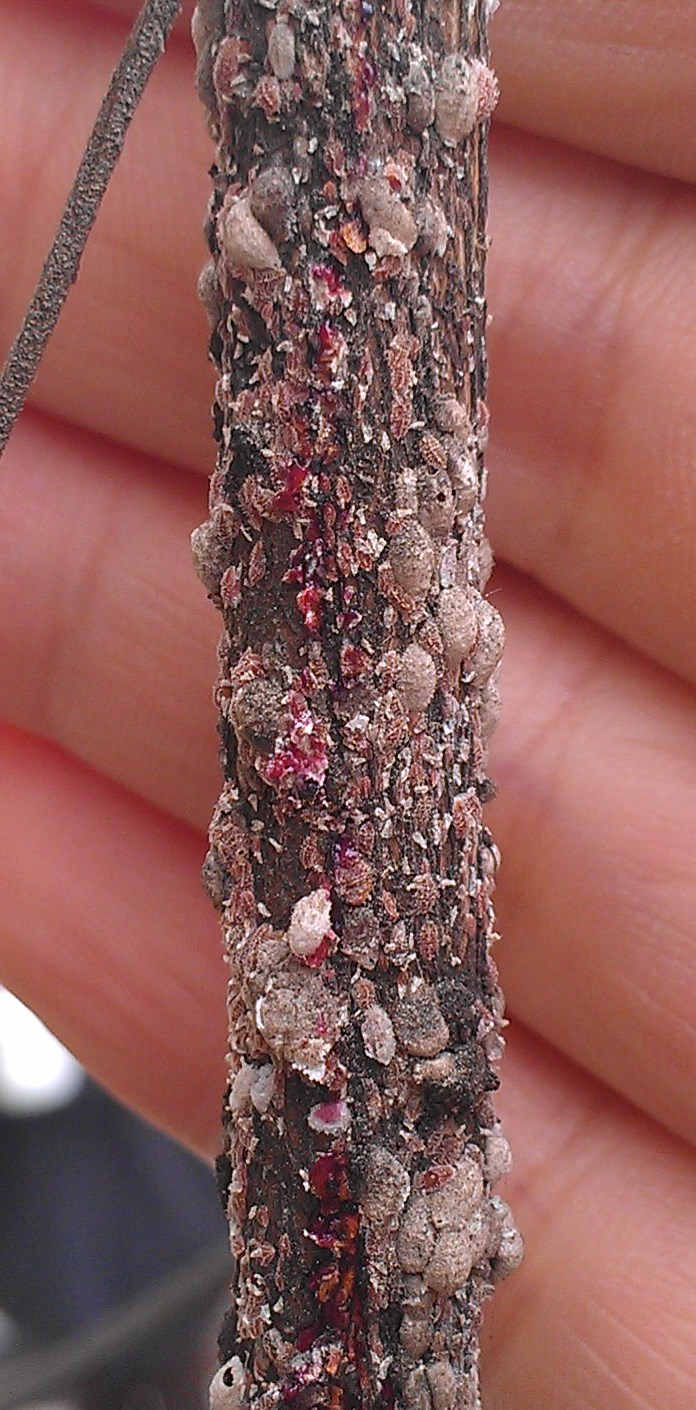
by Gary Knox | Mar 31, 2015
![Figure 1 Note the black sooty mold coating the layers of white and grey scale, believed to be crapemyrtle bark scale, Eriococcus lagerstroemiae. [Photo by Gary Knox]](https://nwdistrict.ifas.ufl.edu/hort/files/2015/03/crapemyrtlescalebark1.jpg)
Figure 1 Note the black sooty mold coating the layers of white and grey scale, believed to be crapemyrtle bark scale, Eriococcus lagerstroemiae. [Photo by Gary Knox]
Symptoms and Appearance
An early symptom of crapemyrtle bark scale is black sooty mold covering extensive areas of leaves and stems as a result of honeydew exuded by the scale (Fig. 1). Individual scale insects are white to gray in color and ooze pink when crushed (Fig. 2). Large populations build up in branch crotches and extend up branches, appearing crusty white to gray. This scale usually is not present on new growth, leaves or slender stems unless infestations are heavy.
For more information and additional photos
Resources, up-to-date information and additional photos about crapemyrtle bark scale may be found at http://www.eddmaps.org/cmbs/. This website will be the major portal for information about this pest.
![Figure 2. This white to grey colored scale oozes pink when crushed. [Photo by Gary Knox]](https://nwdistrict.ifas.ufl.edu/hort/files/2015/03/crapemyrtlescale2.jpg)
Figure 2. This white to grey colored scale oozes pink when crushed. [Photo by Gary Knox]
Research
Research on crapemyrtle bark scale is ongoing. Scientists from the University of Florida, LSU, University of Arkansas and Texas A&M are collaborating to develop Best Management Practices to manage crapemyrtle bark scale in the nursery and landscape. Initial research is examining the biology of the host-insect interaction to better understand its life cycle and stages when it may be most susceptible for control. Additional research will evaluate pesticides and other IPM strategies for managing this pest.
The expanding distribution of this scale and my personal observations of crapemyrtle bark scale throughout China suggest this scale could have a widespread and severe impact on crapemyrtles in landscapes. Please be on the lookout for crapemyrtle bark scale, and report sightings to your local county extension agent and Florida Department of Agriculture and Consumer Services Division of Plant Industry.












![Figure 1 Note the black sooty mold coating the layers of white and grey scale, believed to be crapemyrtle bark scale, Eriococcus lagerstroemiae. [Photo by Gary Knox]](https://nwdistrict.ifas.ufl.edu/hort/files/2015/03/crapemyrtlescalebark1.jpg)